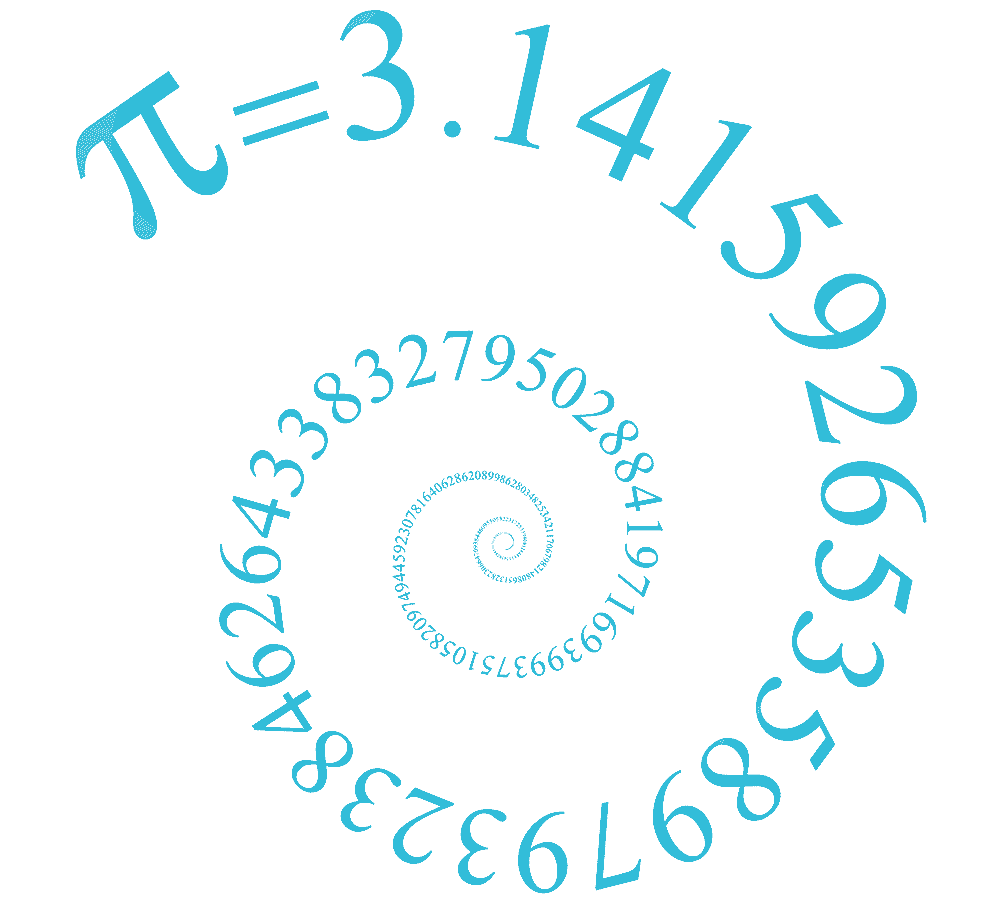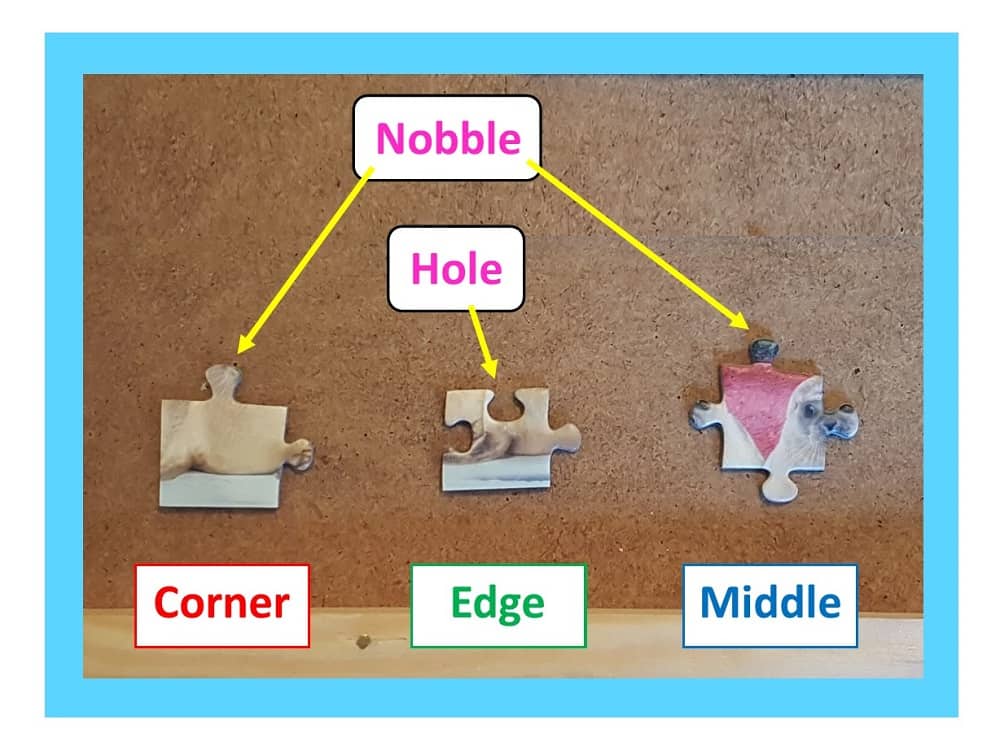First of all, it’s easy to see that a 2000 piece jigsaw is more than twice as hard as a 1000 piece jigsaw. To see why: imagine having two 1000 piece jigsaws that are of a similar style. Rather than complete them both separately (which would obviously be twice as hard as a 1000 piece jigsaw), it would clearly make the task much harder to do if we first mixed all 2000 pieces together. But that is in essence what a 2000 piece jigsaw is: it’s two different 1000 piece jigsaws with the pieces mixed up.
SO HOW MUCH HARDER IS IT?
When I first asked this question, myself and several other mathematician friends suggested that a square law: so twice as many pieces might make it $2^2=4$ times as hard (and 3 times as many pieces would make a jigsaw $3^2=9$ times as hard). We’ll see later how that conjecture panned out.
DEFINITIONS PLEASE!
Now let’s introduce some language.
There are three types of pieces, which I’ll call corner, edge and middle.
Each piece has two or more holes / nobbles (I’ll call these the two types of connectors), and when two connectors are joined by putting a hole and a nobble together, I’ll call that a connection.
COUNTING IS HARD!
A normal 1000 piece jigsaw is a rectangle measuring 25×40 pieces (you might like to think about how I can tell that without having to count. HINT: think of the factors of 1000). Counting the number of each type of piece, we find there are:
4 corner pieces each with 2 connectors;
38+23+38+23=122 edge pieces each with 3 connectors (counting the pieces along each side but ignoring the corner pieces);
and 23×38=874 middle pieces each with 4 connectors (easy to see if you imagine stripping away the outer lines of a 25×40 jigsaw to leave a 23×38 rectangle).
(check: 4+122+874=1000✔)
The corresponding numbers for a 2000 piece jigsaw (which usually measures 40×50 pieces – again check you can see why this is) are 4 corner, 172 edge, 1824 middle pieces.
COUNTING THE CONNECTIONS:
The total number of connectors (holes & nobbles) in a 1000 piece jigsaw is therefore:
(4×2) + (122×3) + (874×4) = 3870 connectors (of which 1935 are holes and the other half nobbles).
Since each connection joins two connectors (one hole and one nobble), this makes a total of 3870÷2=1935 connections that must be made to complete a 1000 piece jigsaw.
Note that this is a lot more than 1000 pieces, since most pieces have more than 2 connectors!
The corresponding numbers for the 2000 piece jigsaw are (4×2) + (172×3) + (1824×4) = 7820 connectors, making a total of 7820 ÷2=3910 connections necessary to complete the 2000 piece jigsaw.
So we need to make more than twice as many connections to complete a 2000 compared to a 1000 piece jigsaw – but only just. The difference can be seen intuitively because the edge is (usually) the easiest part of a jigsaw (because edge pieces have fewer connectors, also we already know where they go: round the edges of the completed puzzle!) and smaller puzzles have a larger proportion of these easier edge pieces (the ultimate being a 2×2 jigsaw, all of whose pieces are corners, or a 2×3 jigsaw, all of whose pieces are corners or edge pieces).
HOW ABOUT COUNTING THE CHOICES?
So far it looks like the 2000 should be about twice as hard as the 1000 jigsaw, but up until now we have ignored the number of choices to be made when trying to find the right piece to connect to a given piece. So let’s now see how a dumb robot might approach our 1000 piece jigsaw. Sam the Robot might randomly find a nobble and then look for the hole that it should connect to. We saw earlier that there are 1935 possible matches, so worst case scenario is 1935 comparisons to be made before Sam finds the right one.
Now Sam chooses another nobble and looks for its matching hole. This time 1934 possible choices and then the second connection is made.
Sam continues in this way, selecting a spare nobble and trying random holes for a match, until the puzzle is completed. The max number of comparisons Sam must make is
$1935+1934+…+2+1 $ (this is $T_{1935}$ – the 1935th Triangular Number, by the way)
$= \frac{1}{2}(1935)(1936)$ (as any A-level mathematician can tell you using the formula for the sum of the terms of an arithmetic sequence)
$=1.87$million comparisons.
Incidentally, this sort of systematic well-defined approach that guarantees to complete a given task in called an algorithm. Algorithms are studied widely in Decision Maths – one of the A-level options.
AND HOW ABOUT FOR THE 2000 PIECE JIGSAW?
The max number of comparisons Sam the not-so-clever Robot must make is:
$3910+3909+3908+…+2+1$
$=\frac{1}{2}(3910)(3911)$
=7.65 million comparisons.
AND THE FINAL ANSWER?
The 2000 piece jigsaw is therefore about 7.65million ÷ 1.87million ≈ 4 times as hard as the 1000 piece jigsaw. The mathematicians’ original conjecture is vindicated! – and e.g. a 3000 piece jigsaw will be $3^2=9$ times as hard as a 1000 piece jigsaw etc.


This assessment, whilst clear and accurate for a puzzle devoid of picture, does exclude the influence of surface pattern and colour that creates vast differences in difficulty between any two puzzles of the same kind. This aspect is, of course, impossible to calculate.
Thank you for a splendid piece of work on a subject upon which I have never, as a jigsaw puzzle fan, reflected. Some really posh puzzles with fake edge pieces that exclude the option to build the rectangular frame first, and ‘whimsy’ pieces, shaped thematically to the jigsaw’s picture content, still lie intriguingly beyond this equation, however….
Thanks for your thoughts and kind comments, Roddy! Like you say there is much more to this than my simplifications but hopefully it’s provided some food for thought!
Totally agree, when it comes to how I think you complete a jigsaw puzzle a lot of it has to do not with the math laid out. Sorting pieces as they relate to picture, is a large part of it. That greatly reduces the possible connections for each piece as you begin to de-randomize so to speak the pieces.
My partner, Rachel, and I love to do puzzles. We usually do either 1000 or 2000 piece puzzles. And generally feel like the difficulty is nearly the same. I think this is partly because the size of the piece are nominally the same and scale so to speak of the pieces to the image it creates are nominally the same. There are definitely more intricate details in some images than in others so a totally like for like comparison isn’t really possible. I imagine this is likely due to the puzzle makers realizing that there is a level of detail that is challenging but where you can still relate the piece to the image and they don’t want to go beyond that. 750/500 piece puzzles seem to have larger pieces and the scale of the portion of the image/detail on pieces of the overall picture is different making them much easier.
Then the management and sorting of the pieces then comes into it and the sheer volume of pieces probably does equate to being 4x the work. But after that point it’s probably just 2x when you actually start putting it together.
Rachel does lean towards 2000 pieces as more puzzle is better haha, and I lean towards 1000 as they take up half as much space and are more or less the same challenge to put the pieces together but are less work to deal with the volume of pieces. In the end the image and overall quality usually is the deciding factor. I typically do the majority of the sorting and Rachel will start building when we get the edges, typically I feel like I do less of the 2000 piece puzzles as more of my time is spent sorting and she can build faster that I can sort. Versus with 1000 pieces I can sort and start working on putting it together with a larger percentage of the puzzle left to complete.
Thanks this was a fun and interesting read! I definitely have thought a lot about it haha.
Thank you Justin for your thoughts. It’s really interesting to get a perspective from the jigsaw puzzling community on this issue. Good luck to you and Rachel with your next jigsaw(s)!
Hi Barney
What a great calculation! In real life, I agree with Roddy that puzzlers also sort by areas of similar colour, which can help them, effectively dividing a larger puzzle into several small ones which are quicker to complete.
A 500 piece puzzle was completed by the world champion in 34 minutes, whilst the UK champion completed a 1000 piece puzzle in 1 hour and 40 minutes – roughly three times as long.
On puzzle forums, people talk about a 500 piece puzzle taking an average of just under 3 hours, and a 1000 piece taking 6 hours – so roughly 2.5 times.
In conclusion, I think it depends on how many cups of tea you have! I worked in a jigsaw puzzle company for over 20 years and have actually written an article on it, too, if you wanted a read :
https://www.everythingjigsaw.com/how-long-do-jigsaw-puzzles-take/
Thanks again for a great article!
Geoff
Geoff: 34 minutes for 500 pieces that is insane! I was very entertained to read those numbers in your comment – I was delighted recently to complete 1000 pieces in just under 24 hours after first opening the box. All the best, Barney